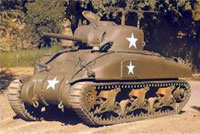M4 Sherman Tank

The U.S. Army M4 medium tank was tested at the Aberdeen Proving Grounds in Maryland, and went into production in October of 1941. Eleven different factories were responsible for constructing the M4. The tank went into service in late 1942.
The Sherman name was a British designation, and while it was not part of the official name of the M4 tank, it was commonly known and used among U.S. troops. The M4 was used by the U.S. Army, U.S. Marines, Britain, Canada and the Free French.
The M4 was specifically designed to favor speed and mobility over firepower. This was in accordance with U.S. Army doctrine that the tank would function as an infantry support weapon, and thus would have to be capable of keeping up with rapidly moving ground troops. To some extent, the M4 was not designed to fight other tanks.
Because of these design factors, the M4 was thinly armored and carried a small main gun. Compared to German armor, the M4 was clearly outmatched. The crews of M4 tanks were vulnerable to the superior penetrating fire of German tank guns, and were themselves hardly able to scratch the heavier armor of their German counterparts.
What the M4s lacked in armor, firepower and survivability, they made up for in sheer numbers, a higher rate of fire, increased mobility, and much simpler maintenance. In late 1944 the M4 was outfitted with a 76mm gun, and its suspension system upgraded in early 1945.
The M4 tank hull was used for a variety of vehicles, including the M32 tank recovery vehicle, M7B1 self-propelled howitzer, M10 Wolverine, and numerous British designs including the Firefly. For D-Day, one of the most significant variations was the amphibious DD Tank.
Both the standard M4 and its DD version were inadequate for the close-support role that they were intended to fill on D-Day. One of the M4's few strengths, mobility, was restricted on the confined beaches of Normandy, and the weaknesses of its light armor and firepower were clearly evident. German defenders quickly attacked any tank that made it to shore, and many were destroyed before they could leave the beach or provide any support fire. The shingle at Omaha Beach was impassable by armor, and it was not until engineers could open up paths and the beach exits were secured that the M4 could make its way off the beach and make use of its maneuverability.
Ironically, the hedgehog obstacles that littered the beaches would later be used to help Allied tanks break through the numerous hedgerows that cross-crossed the Normandy countryside. Cut up and welded to the front of tanks, these chunks of metal allowed armor to rapidly slice through the hedgerows and quicken the Allied attack inland.
Between 1942 and 1945 approximately 48,000 M4 Sherman tanks were built. Production originally started at 1,000 tanks a month and was eventually upped to 2,000 tanks a month. Among the companies that produced the M4 Sherman were the Pressed Steel Car Co., Baldwin Locomotive Works, American Locomotive Co., Pullman Standard Car Co., and the Detroit Tank Arsenal. The production output of the M4 design was more than all of the tanks produced by both the British and the Germans during the war.
Notes
With the exception of a few promotional photos, an M4 Sherman tank is only briefly seen in the background of a few Omaha Beach scenes, and at the end of the film as U.S. troops move into the French village of Ramelle. DD Tanks, based on the M4 Sherman, are mentioned but never seen.
